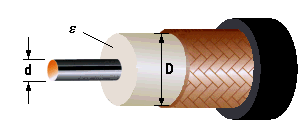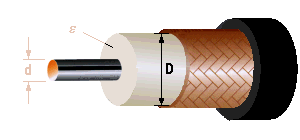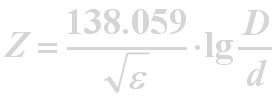Coaxial Lines

Figure 1: Coaxial line
Coaxial Lines
Coaxial cable is defined as two concentric wires, cylindrical in shape, separated by an insulating
dielectric of some type. One wire is the center conductor and the other is the outer conductor
(usually called a shield).
The dielectric maintains a constant capacitance between the two conductors,
which is very important in radio transmission. The dielectric is soft and deforms
easily if tied too tightly or with the wrong type of tape.
The conductors are covered by a protective jacket. The protective
jacket is then covered by an outer protective armor.
Coaxial cables are used as transmission lines and are constructed to provide protection
against outside signal interference.
![]() useful coaxial line equations
useful coaxial line equations
There are two types of coaxial lines, flexible (solid) coaxial line and rigid (air) coaxial line. The physical construction of both types is basically the same; that is, each contains two concentric conductors.
Flexible coaxial lines


Figure 2: Flexible coaxial line


Flexible coaxial lines are made with an inner conductor that consists of flexible wire insulated from the outer conductor by a solid, continuous insulating material. The outer conductor is made of metal braid, which gives the line flexibility. Early attempts at gaining flexibility involved using rubber insulators between the two conductors. However, the rubber insulators caused excessive losses at high frequencies.
Rigid coaxial lines
The rigid coaxial line consists of a central, insulated wire (inner conductor) mounted inside a tubular outer conductor. The inner conductor is insulated from the outer conductor by insulating spacers or beads at regular intervals. The spacers are made of pyrex, polystyrene, or some other material that has good insulating characteristics and low dielectric losses at high frequencies.
The chief advantage of the rigid line is its ability to minimize radiation losses. The electric and magnetic fields in a two-wire parallel line extend into space for relatively great distances and radiation losses occur. However, in a coaxial line no electric or magnetic fields extend outside of the outer conductor. The fields are confined to the space between the two conductors, resulting in a perfectly shielded coaxial line. Another advantage is that interference from other lines is reduced.

Figure 3: Semi-Rigid- coaxial line
The rigid line has the following disadvantages:
- it is expensive to construct;
- it must be kept dry to prevent excessive leakage between the two conductors; and
- although high-frequency losses are somewhat less than in previously mentioned lines, they are still excessive enough to limit the practical length of the line.
Semi-rigid cable is a coaxial form using a solid silver-plated copper outer sheath. It requires special care to bend and install and is relatively expensive but it offer a good electrical performance of any coaxial transmission line.
